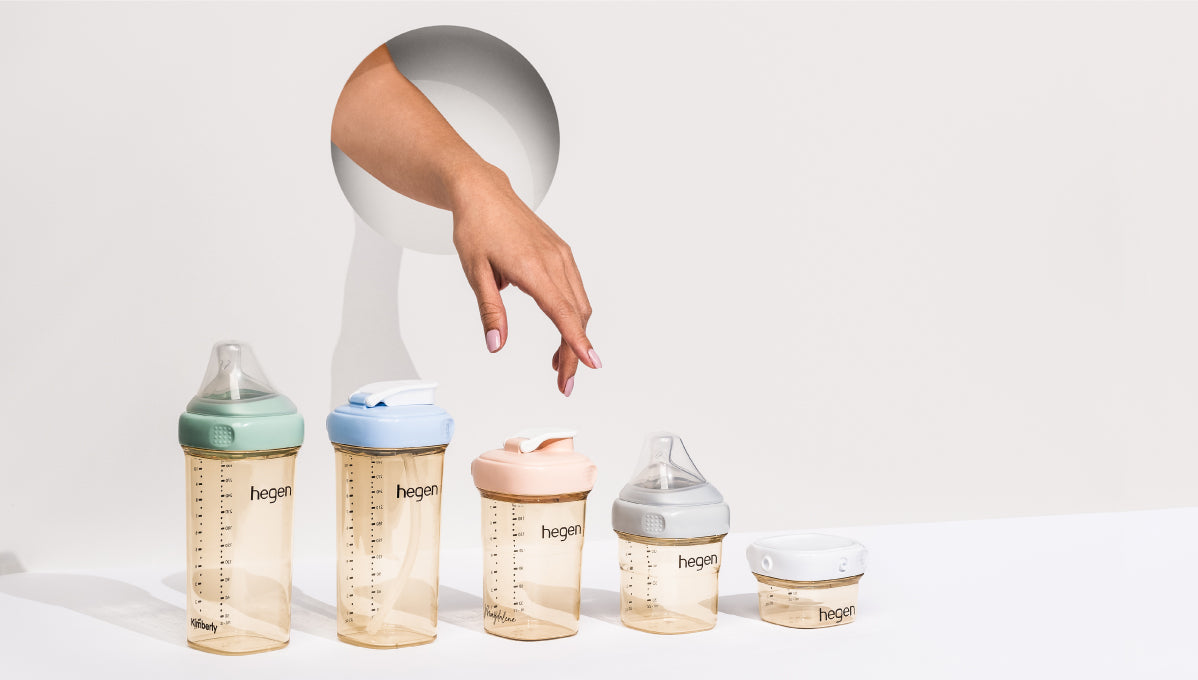Some women cringe at the idea of being hooked up to a machine, while some prefer it over direct latching. Whichever you choose, just know that you are working hard to make nutritious liquid gold filled with antibodies for your newborn.
Two decades ago, breastfeeding mothers were not blessed with the sheer diversity of breast pumps that you find in the market today. Before handbag-friendly USB-powered devices were created, we had to endure clunky oversized pumps that sounded like lawnmowers! These days they can be as silent as a laser printer, fit into the palm of your hand, and still boast the vacuum power of a hospital-grade pump.
With all the sleek modern features found in today’s breast pumps, mums find it hard to just stop at one. In fact, it’s quite common for a breastfeeding mother to have at least two devices – one for home use and another to leave in the office. A great mobile device is Hegen’s Double Electric Breast Pump. It’s small but mighty at only 230g with 12 expression levels, 3 expression rhythms with a total of up to 36 personalised expression levels and suction pressure of 300 mmHg ± 20% -- all benchmarked to a hospital-grade pump.
Once you’ve shortlisted your pump of choice, the hard work is customising the expression levels to suit your baby’s suckling rhythm and desired output. Typically, most breast pumps will have a Massage mode to stimulate let-down, and an Expression mode for continuous expression.
Whichever mode you choose, just remember that pumping should never be painful. In fact, it should be relaxing, allowing the happy hormones to surge through your body and elevate oxytocin levels for breastmilk to flow. If it hurts, consider getting a larger flange so there’s more wiggle room for your nipple to stretch, and lower the suction levels of your pump.
Once you’re ready, let’s start pumping! Here are the 7 most important steps to know.
Recognise that pumping is different from latching
Nursing your baby from the boob should always be the default for a breastfeeding mother, mostly because direct feeding is a bonding experience that releases hormones responsible for the let-down and flow of your milk. But that’s not to say that pumping is ineffective. It’s just that it cannot mimic the emotional aspects of that you get from nursing. To help with this, you can look at some photos of your baby or switch on the baby monitor – looking at your bub will get you smiling for sure!
Pump as often as baby feeds
Pumping is different for every woman, so it’s important to figure out what method works best for you – something you’ll get better at with time. If you are primarily nursing and only pumping when away from baby, such as in the office, then you would be pumping about 3 times at work on a schedule that resembles your little one’s normal feeding times.
If you are exclusively pumping, you should pump as often as baby eats, which is between 8 to 12 times a day. As your baby gets older though, that number will likely decrease. If you are trying to increase your milk supply, then adding in a few extra pump sessions a day, or even a power pumping session at night, can really help to boost your production.
Know how long to pump
The big question on everybody’s mind is how long should a breastfeeding mother pump? Well, that depends. If you primarily nurse your baby, you can pump for another 10 – 15 minutes after a latch if you wish to boost milk supply. Exclusive pumping mummies should be pumping at least 20 minutes or until the milk stops flowing, and an extra 5 minutes thereafter to help stimulate more milk production. The logic behind this is when you leave milk in your breasts, then you are telling your body that you don’t need any more milk. The your body will in turn stop producing that extra milk and your supply will decrease.
Output will always vary
Some days you’re expressing a full bottle (or two!), other days you can barely hit the 100ml mark. All very normal and nothing that needs medical attention unless you have really bad engorgement and fever.
When your hormones are out of balance due to sickness, menstruation, insufficient hydration, poor diet or pregnancy, breastmilk output can suffer. Always take the best care of yourself so that you can produce better quantity and quality milk. Tip: Your body naturally produces more prolactin in the middle of the night and early morning, which means a higher chance of more milk. You can take advantage of that and pump at these times.
The last thing you should be doing is comparing your breastmilk to other mums. And don’t be too quick to blame the pump either – although you should always check that all the parts are affixed tightly and there are no tears and holes that could drastically affect suction. It’s always good to have spares for breast pumps & accessories like valves, tubes, seals, diaphrams, flanges.
Aim for multiple let-downs
For some reason, some mums release more milk during the let-down mode when hooked up to a machine rather than the expression mode. Maybe because it resembles baby's gentle suckles. If you fall into this category, it's good to toggle back to the massage mode 2-3 times during your pump session.
Hegen’s electric pump has an automatic 2-minute massage mode that helps to stimulate let-down with the option of adjusting the rhythm (or suckling pattern) by toggling between 3 petal icons, as seen on the LED panel. You can return to massage mode as many times as you like if you feel you get more milk output. As a rule of thumb, most mums of newborns stay on Petal 1 for the first 3 months, and move up a petal every 3 months.
Calm your mind, have a massage!
The more stressed you are, the harder it is to let-down, as it’s controlled by your state of mind. Some easy tricks to overcome this is deep breathing, meditation, a funny movie, not staring at the bottle, and a massage – something that only Hegen’s breast pump offers. Simply swap out the eCap with a Kneading Ring and you instantly get a TCM-inspired cupping massager that helps stimulate circulation, calm swelling or soreness and bring on the happy hormones. When applied to certain meridian points – top part of shoulders at mid-section, 2in under armpits, 1in under nipple, and centre of chest plate – you may notice a surge in breastmilk.
Manual express to get more out
Some women may have one lazy boob that likes to hold on to more milk than the other. This is normal. Applying something warm while pumping can help loosen up the milk so it flows easier. Some mums simply roll a warm flask on their breasts or use a heated massager to do double duty. You may also need to hand express or use a manual pump for deeper expression to draw out breastmilk. Hegen’s electric pump can instantly turn into a manual pump with the quick switch of a lever.





